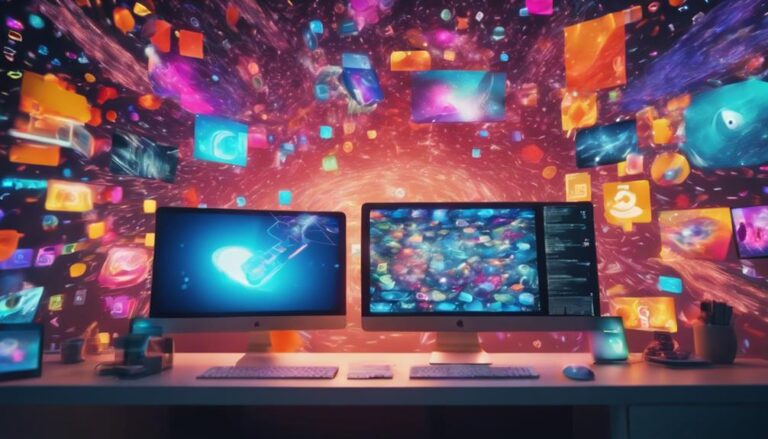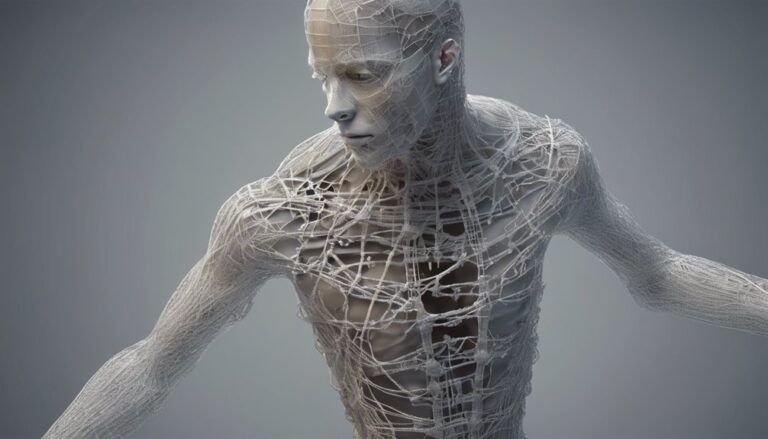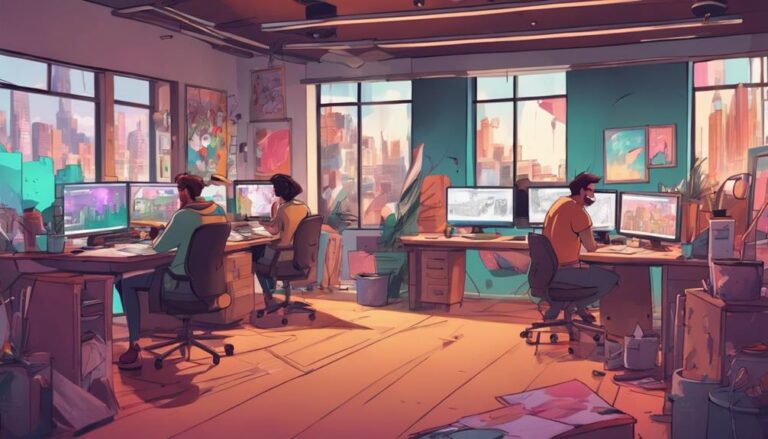Animation Services
By leveraging animation services, you're unlocking a world of limitless creative possibilities where complex ideas are transformed into engaging stories that captivate your audience and convey your brand's message in a way that live-action videos often can't. You'll enjoy cost-effective, time-efficient production that allows for quick responses to market trends and customer needs. From 2D motion graphics to 3D modeling and realistic simulations, the right studio will help you choose the perfect technique to convey your vision. And as you explore the world of animation, discover the key to crafting a compelling narrative that really resonates with your target audience.
Key Takeaways
- Animation services convey complex ideas in an engaging and simplified manner, increasing brand awareness and customer engagement.
- Cost-effective compared to live-action videos, animation services require a smaller budget for equipment, location, and talent.
- A well-structured animation studio with a proven track record and a collaborative environment is essential for successful projects.
- Effective project planning and execution involve clear communication, strong team dynamics, and a clear understanding of the client's vision.
- Measuring animation success involves tracking emotional connection, engagement, and conversion metrics to understand audience engagement.
Benefits of Animation Services
The incorporation of animation services in your marketing strategy can significantly elevate your brand's storytelling capabilities.
By leveraging animation, you can convey complex ideas in an engaging and simplified manner, making it easier for your audience to understand and connect with your message. This, in turn, can lead to increased brand awareness, customer engagement, and ultimately, conversions.
One of the key benefits of animation services is their cost-effectiveness.
Unlike live-action videos, which require a significant budget for equipment, location, and talent, animation can be produced at a fraction of the cost. This makes it an attractive option for businesses with limited marketing budgets.
Additionally, animation is a time-efficient way to produce high-quality content.
With the ability to create and edit animations quickly, you can respond to market trends and customer needs in a timely manner.
Types of Animation Techniques
When you're exploring the world of animation, you'll come across two fundamental techniques that can bring your vision to life: 2D computer animation and 3D modeling techniques.
2D computer animation is all about creating motion graphics and characters within a two-dimensional space, using software to control every frame.
Meanwhile, 3D modeling techniques allow you to build and animate three-dimensional models, adding depth and texture to your animations.
2D Computer Animation
D Computer Animation
Immersed in a world of 3D models, textures, and lighting, you're about to dive into the realm of computer animation techniques.
Computer animation uses software to create the illusion of movement in digital environments. This technique is a fundamental component of 3D visualization, allowing artists to bring their ideas to life in a realistic and captivating way.
When exploring computer animation, you'll be amazed by the level of digital realism that can be achieved.
- *Emotional connections*: By using subtle animations and realistic lighting, you can create emotional connections with your audience.
- *Realistic simulations*: Computer animation techniques allow you to simulate real-world physics, such as water, fire, and destruction.
- *Immersive experiences*: With computer animation, you can transport your audience to new worlds, creating immersive experiences that engage and captivate.
3D Modeling Techniques
D Modeling Techniques
Modeling techniques are the backbone of computer animation, allowing you to shape and mold digital objects into three-dimensional masterpieces. With the right modeling software, you can bring your ideas to life and achieve geometric precision. When choosing a modeling technique, consider the desired level of detail, the complexity of the model, and the software you'll be using.
Here's a comparison of popular modeling techniques:
| Technique | Description | Uses |
|---|---|---|
| Polygon Modeling | Uses 2D polygons to create 3D objects | Film, TV, and video games |
| NURBS Modeling | Uses curves to create smooth surfaces | Automotive and aerospace design |
| Subdivision Surface Modeling | Uses a network of polygons to create detailed models | Film, TV, and product design |
Each technique has its strengths and weaknesses, and the right choice will depend on your specific needs and goals. By mastering different modeling techniques, you can unlock new creative possibilities and achieve stunning results. Whether you're an artist, designer, or animator, understanding modeling techniques is essential for creating believable and engaging 3D models.
Choosing the Right Studio
When selecting an animation studio, you need to consider the studio's size and structure to ensure it aligns with your project's scope and budget.
You also need to assess the studio's experience and expertise in your desired animation technique, as well as their ability to communicate effectively and collaborate with your team.
Studio Size and Structure
Several key factors come into play when selecting an animation studio, but one often overlooked aspect is the studio's size and structure.
A studio that's too large may struggle to maintain a cohesive vision, while one that's too small may lack the resources to bring your project to life. You need to find a studio that strikes the perfect balance between creativity and efficiency.
When evaluating a studio's size and structure, consider the following:
- *A collaborative environment* fosters a sense of community and creativity, where artists and technicians can bounce ideas off each other to create innovative solutions.
- *A flat organizational hierarchy* enables faster decision-making and a more agile response to changes in your project.
- *A culture of open communication* ensures that your vision is clearly understood and executed, and that any issues are addressed promptly.
A well-structured studio is essential for successful animation projects.
It's crucial to consider the studio's culture and team dynamics when making your decision.
This will help you choose a studio that shares your vision and can bring your project to life in the most effective and efficient way possible.
Experience and Expertise
As you weigh your options for an animation studio, a crucial factor to consider is the level of experience and expertise they bring to the table.
A studio with a proven track record of delivering high-quality animations will have a team with strong dynamics, where each member's skills complement the others to create a cohesive visual experience.
Look for studios that have adapted to the industry's evolution, staying up-to-date with the latest software, trends, and technologies.
A studio's experience and expertise will also be reflected in their ability to solve complex visual problems and deliver innovative storytelling.
Check their portfolio for a diverse range of projects, showcasing their versatility and range.
Pay attention to the level of detail and attention to detail in their work, as well as their ability to meet deadlines and deliver results under pressure.
When evaluating a studio's experience and expertise, ask about their team's credentials, including awards, nominations, and industry recognition.
A studio with a strong reputation and a team of industry experts will be better equipped to deliver a high-quality animation that meets your needs.
Communication and Collaboration
Effective collaboration is key to a successful animation project, and it all starts with choosing a studio that communicates clearly and openly with you, their client.
You want to work with a studio that shares your vision and is dedicated to bringing your project to life. When you're considering different studios, pay attention to how they communicate with you.
Do they respond promptly to your inquiries? Are they transparent about their project management processes?
A studio with strong team dynamics and effective project management is essential for a successful collaboration.
You want to work with a team that's passionate, motivated, and dedicated to delivering high-quality results.
Here are some key signs to look for:
- *A clear and concise communication plan* that outlines how the studio will keep you informed throughout the project.
- *Regular check-ins and progress updates* that ensure you're always in the loop.
- *A willingness to listen and adapt* to your feedback and changing project requirements.
Understanding Your Target Audience
When developing an animation, it's essential that you pinpoint your target audience from the get-go, as this demographic will ultimately drive the creative direction of your project.
Understanding your target audience is key to creating an engaging animation that resonates with viewers. To achieve this, you'll need to develop audience personas that outline the characteristics, preferences, and behaviors of your ideal viewer.
These personas will help you tailor your animation's style, tone, and narrative to meet the needs and expectations of your target audience. By doing so, you'll increase viewer engagement and create a more immersive experience.
Consider factors such as age, occupation, interests, and viewing habits when crafting your audience personas. Additionally, think about the devices and platforms your audience will use to consume your animation, as this will impact the technical specifications of your project.
Crafting a Compelling Storyline
A well-crafted storyline is the heartbeat of any successful animation, pumping life into the characters, settings, and plot twists.
When crafting a compelling storyline, you're not just telling a story – you're creating a journey that immerses your audience and leaves a lasting impact.
A good storyline is one that's layered, with character arcs that unfold gradually, revealing the complexities and depth of your characters.
To evoke emotion in your audience, focus on creating moments that resonate with them on a deeper level.
This can be achieved by:
- Introducing unexpected plot twists that challenge the audience's expectations
- Creating relatable characters that undergo significant transformations
- Incorporating symbolism or metaphors that add layers of meaning to the narrative
The Role of Music and Sound
The Role of Music and Sound
The soundtrack of your animation is more than just background noise – it's an integral part of the narrative, elevating the visuals and drawing your audience in. You can use music and sound effects to create a sonic identity for your brand, setting you apart from others in your industry. A well-crafted soundtrack can evoke emotions, build tension, and create a lasting impression on your viewers.
| Sound Elements | Emotional Impact | Technical Considerations |
|---|---|---|
| Background Music | Sets the tone and mood | Ensure it's not overpowering the dialogue |
| Sound Effects | Enhances the visuals and creates realism | Use Foley techniques for authenticity |
| Voiceovers | Provides context and narration | Record high-quality audio with minimal background noise |
| Silence | Creates anticipation and tension | Use strategically to avoid awkward pauses |
When creating your soundtrack, consider the emotional impact you want to have on your audience and the technical considerations needed to achieve it. By combining music, sound effects, and voiceovers, you can create a sonic identity that resonates with your viewers and leaves a lasting impression.
Measuring Animation Success
Measuring Animation Success
Your animation is live, and the visuals are captivating – now it's time to gauge its impact.
To determine the success of your animation, you need to track the right animation metrics.
These metrics will help you understand how your audience is engaging with your content and what's driving that engagement.
When it comes to measuring animation success, there are several factors to consider.
- *Emotional Connection*: Is your animation evoking the desired emotions from your audience? Are they feeling inspired, educated, or entertained?
- *Engagement*: Are viewers watching your animation until the end? Are they sharing it with others or taking action as a result?
- *Conversion*: Is your animation driving the desired outcome, such as generating leads, making sales, or increasing brand awareness?
Common Animation Challenges
Motion picture magic – it's what draws viewers in, but what happens when technical glitches or creative missteps hinder your animation's potential.
As you work to bring your vision to life, you're likely to encounter several common animation challenges that can make or break your project.
One of the most significant hurdles is budget constraints. With limited financial resources, you may struggle to achieve the level of quality you want, forcing you to make tough decisions about what to sacrifice.
Another challenge you'll face is unrealistic deadlines. When timelines are overly aggressive, you risk rushing through critical stages of the animation process, which can lead to subpar results.
This can be particularly problematic when working on complex projects that require meticulous attention to detail.
To overcome these challenges, it's essential to prioritize planning, set realistic expectations, and communicate effectively with your team and stakeholders.
By doing so, you can minimize the impact of budget constraints and unrealistic deadlines, ensuring your animation stays on track and meets your creative vision.
Effective project management is key to delivering high-quality animation that captivates audiences.
Future of Animation Technology
As you step into the realm of cutting-edge animation, you're met with an explosion of innovative technologies that are revolutionizing the industry.
The future of animation technology is shaping up to be a world where creators can push the boundaries of storytelling and immersion. Virtual reality (VR) and augmented reality (AR) are becoming increasingly prominent, enabling animators to craft experiences that transport viewers to new dimensions.
Artificial intelligence (AI) is also playing a significant role in the evolution of animation.
AI-powered tools can automate repetitive tasks, freeing up animators to focus on high-level creative decisions. This fusion of human ingenuity and machine learning is giving birth to breathtaking visuals and unparalleled realism.
- Imagine being able to step into the world of your favorite animated film and interact with the characters in real-time.
- Picture a future where AI-generated animations can be tailored to individual viewers' preferences and emotions.
- Envision a realm where virtual reality experiences are indistinguishable from reality itself.
Frequently Asked Questions
What Is the Average Cost of Animation Services per Minute?
When setting a budget, you're probably wondering what you'll pay per minute. Industry standards dictate that costs vary greatly, but on average, you'll spend around $3,000 to $10,000 per minute, considering your project's complexity and budget constraints.
Can I Own the Rights to the Animation After Completion?
When commissioning a project, you'll want to retain creative control. By owning the intellectual property, you'll have full rights to the final product. Typically, you can negotiate ownership with the service provider, but it's essential to clarify this upfront.
How Long Does an Average Animation Project Take to Complete?
When planning a project, you'll want to know how long it'll take to complete. Generally, project scope and complexity dictate the timeline. For animation, this means considering factors like character design, CGI, and storyline intricacy.
Can I Make Changes During the Animation Production Process?
You're in control – during a project, you can make changes, exercising your creative freedom. In a healthy collaboration process, you'll work closely with your team to incorporate your vision, ensuring your final product is a perfect reflection.
Do Animation Studios Offer Package Deals or Discounts?
You're likely looking for ways to save on a big project. Many studios offer package deals or discounts, think studio bundles, which can be a cost-effective option. You can also ask about customized plans.
Conclusion
As you bring your animation project to life, remember that a well-crafted storyline, engaging visuals, and a clear understanding of your target audience are key to success. By choosing the right studio and incorporating music and sound effectively, you'll be well on your way to creating a captivating animation that resonates with viewers. Stay ahead of the curve by embracing the latest animation technology and measuring your project's impact along the way.







